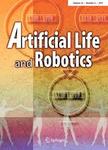版权所有:内蒙古大学图书馆 技术提供:维普资讯• 智图
内蒙古自治区呼和浩特市赛罕区大学西街235号 邮编: 010021

作者机构:Hiroshima Univ Grad Sch Engn 1-4-1 Kagamiyama Hiroshima 7398527 Japan Univ Toyama Grad Sch Sci & Engn 3190 Gofuku Toyama 9308555 Japan
出 版 物:《ARTIFICIAL LIFE AND ROBOTICS》 (人工生命与机器人)
年 卷 期:2018年第23卷第4期
页 面:547-554页
核心收录:
学科分类:12[管理学] 1201[管理学-管理科学与工程(可授管理学、工学学位)] 08[工学] 0811[工学-控制科学与工程]
基 金:Japan Society for the Promotion of Science JSPS (17H01249 17K14627)
主 题:Swarm robotics Evolutionary robotics Task specialization Division of labor
摘 要:Redundancy in the number of robots is a fundamental feature of robotic swarms to confer robustness, flexibility, and scalability. However, robots tend to interfere with each other in a case, where multiple robots gather in a spatially limited environment. The aim of this paper is to understand how a robotic swarm develops an effective strategy to manage congestion. The controllers of the robots are obtained by an evolutionary robotics approach. The strategy of managing congestion is observed in the process of generating a collective path of robots visiting two landmarks alternately. The robotic swarm exhibits autonomous specialization that the robots traveling inside the path activate the LEDs, while the robots in the outer side deactivate them. We found that the congestion is regulated in an emergent way of autonomous specialization by the result of an artificial evolution.